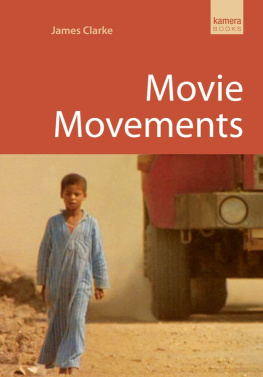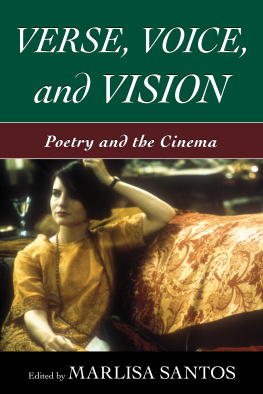Thank you to Hannah Patterson for commissioning this project and to Anne Hudson for her patience and precision. Thanks also to the fine folks in the library at Hereford College of Arts: Jo Lacy, Becky Roberts and Ashley Nunn, and, finally, to Innes Jones, Steve Hanson and Mark Woods.
Tracking shots are a question of morality. Jean-Luc Godard
One reason to go to the movies is because we seek more poetry, joy and transcendence in our lives. Jim Kitses
As soon as it is formed, the skin of history peels off as film. Andr Bazin
I dont make the film. Im only its conscious organiser. Jean-Luc Godard
Just imagine
In the darkness of a film-museum warehouse in Buenos Aires, in the spring of 2008, a pair of hands lifted the lid from a dusty box. The treasure hunter smiled. This was the discovery they had dreamed of, always believing it might be real. From the box, the hands lifted the can and pushed the dust away from its lid, revealing a tattered and fading label on which was marked the ten-letter word: Metropolis.
Granted, perhaps Im over-dramatising this significant moment in film history and film preservation; but the fact remains: on that spring day in Buenos Aires, a lost treasure was at last recovered and the full picture has now been revealed. The full narrative of a landmark film, and its place in the grand tradition of movie movements, could be seen. Eighty-two years after its original release, Metropolis could finally be screened in its complete form, the full span of its human drama playing out against its immense, intricately designed and mesmerising future world. Metropolis, like all of the films explored in this book, has, I think, the power to transform the medium, transport the audience and transcend the immediate context of being just a film.
Consider a Renaissance painting. That was the first image I was asked to think about when I enrolled as a student of film at the University of Warwick. Our teacher, VF Perkins (the last time I saw him, in the summer of 1993, Im happy to recall that he was wearing a Foghorn Leghorn T-shirt), ran a series of still images on screen and encouraged us to think about how they functioned. We were perplexed. We were there to study films pictures that moved and had sound too. Soon enough, however, we began to get into the flow of thinking that he was hoping wed find. During the following session, we were asked to select a photograph from a magazine of our choice. Our assignment was to write a short essay about the qualities we perceived in the image, explaining how the image prompted us to respond. Finally, as we edged towards the end of our first term, with VF teaching, we began to think about moving pictures, excavating ideas about, and responses to, the ways in which they beguiled us. The real epiphany, though, came when VF put the austere domestic Japanese drama Late Spring ( 1952) on a level playing field with the playful and ultra-Hollywood movie musical The Pirate (Vincente Minnelli, 1948), claiming that both movies offered insights into human experience and did so via an inventive and rigorous filmic style. I guess you could say that we were treasure hunting. Perhaps thats the key activity that we, and the cinema, have in common.
No matter what the form, the genre, the era, the intention, the reception or the source of origin, films send their characters, and, by necessary extension, their audiences, on journeys to unlock ways of seeing themselves and the world. Its a journey that never ends, appealing to both our voyeurism and our narcissism.
We watch films, then, to uncover their secrets and to enjoy and understand their re-imaginings of the world. We also make efforts to work out how the mysterious allure of storytelling functions as it spins its charms, threading them through our daily lives and often delivering a sucker punch to the soul. Often we dont even realise this is happening. Were just grateful for being entertained, whether by the seriousness of a Bergman film or the outright kinetic comedy of a Chuck Jones film.
The movies are about us. You and I. We are the movies. I use that word movie sincerely: moving pictures are the form and they move our thoughts and feelings to new places.
Telling stories is an essential part of what it is to be human and the enjoyment in sharing stories is one way of connecting our individual, sometimes enclosed, experience with the wider world. Narratives are one of the primal and powerful ways in which we strive to understand our place and our relationship to our own selves and to others, as we are and as we would like to be. In his creatively empowering book, The Origin of Stories, Brian Boyd writes that Art becomes compulsive because it arouses pleasure, and it arouses pleasure because, like play, it fine-tunes our systems
This Kamera Books title explores the ways in which a range of key iconic movies from around the world have opened our hearts and minds, fine-tuned our systems (to borrow from the excerpt above), and served to advance, and evolve, the place, impact and possibilities of cinema globally.
In a landmark essay about cinema, the film theorists Jean-Luc Comolli and Paul Narboni indicate that every film is political, inasmuch as it is determined by the ideology which produces it.
The qualities that Jim Kitses suggests a film possesses, as quoted above, are, I think, very true of the films discussed and cited in this book.
Jean Renoir, the film director of titles such as La Grande Illusion (1937) and La bte humaine (1938), once encouraged fellow filmmaker Bernardo Bertolucci to always leave a door open on his film set. When Bertolucci asked why, Renoir explained that this would allow the unexpected and the spontaneous to weave its way into the essentially predetermined world of film production. Who knew what might pass by, or occur just beyond the world of recreated, re-staged, re-imagined life? Certainly, Renoirs is a good creative lesson and, like many such lessons, serves as a pretty viable life lesson too. What Renoir was getting at underpins many, if not all, of the films explored in this book. Im okay with being sweepingly sentimental here: the films written about on these pages enrich life and light up our hearts and minds.
Films, then, can be many things: a compass, a comfort, a confounding confection, a challenge, a compulsion to review the world. The American philosopher Stanley Cavell wrote that the question of what becomes of objects when they are filmed and screened has only one source of data for its answer namely the appearance and significance of just those objects and people that are in fact to be found in the succession of films, or passages of film, that matter to us.
Film gives our imaginations the chance to elevate and expand themselves, to open out the range of our sensibilities, and variously transform our everyday experiences and feelings. This remains the great allure of motion pictures, whether a faithful recreation of life in a north-Canadian Eskimo culture or a comically absurd animated allegory of the Cold War.













